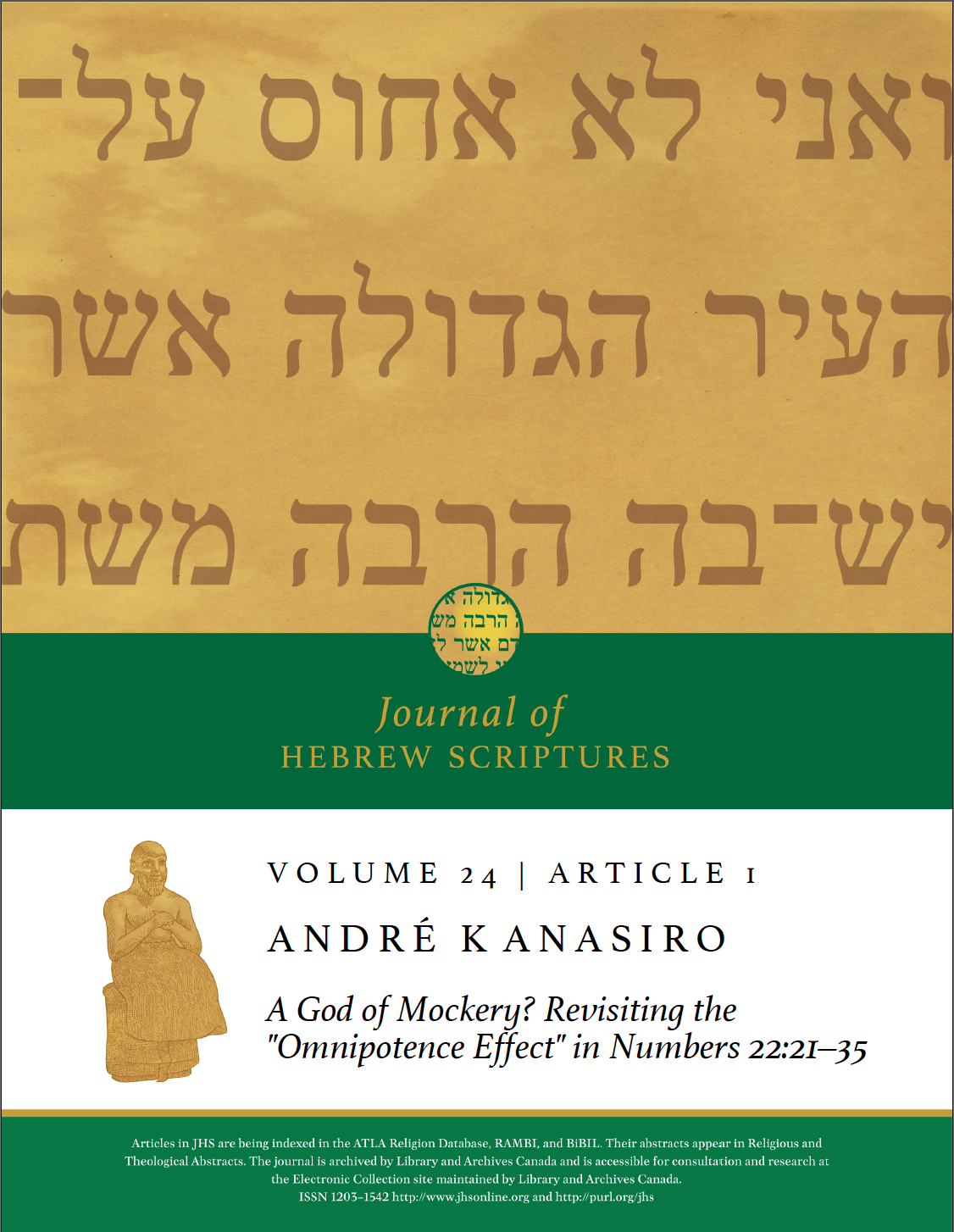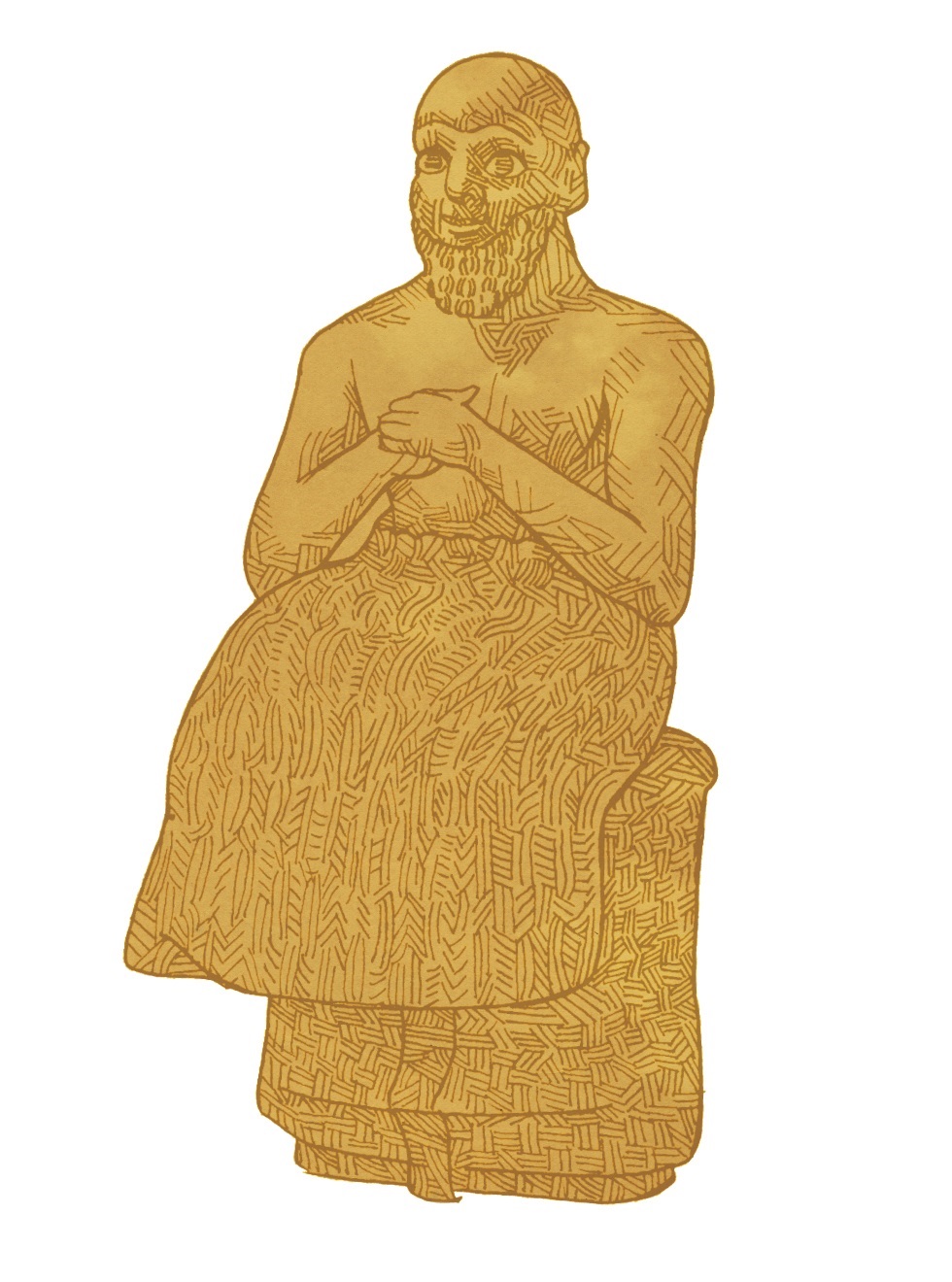A God of Mockery? Revisiting the “Omnipotence Effect” in Numbers 22:21–35
DOI:
https://doi.org/10.5508/jhs29609Abstract
The characterization of YHWH, Israel's only God, is unique in the Hebrew Bible. The deity, while a character in the narrative, transcends the narrative on the level of discourse, rising above other characters, the narrator, and even the reader. This exceptional dynamic of characterization is exemplarily illustrated in the episode of Balaam and the talking jenny (Num 22:21–35), a text loaded with irony and ambiguity that recounts the deliverance of a foreign seer from YHWH’s hands by his jenny. The characterization of YHWH in this text shows a God who manipulates both the narrated world and the formal structure of the text, exemplifying what Sternberg termed the “omnipotence effect.”
References
Albertz, Rainer, and Rüdiger Schmitt. Family and Household Religion in Ancient Israel and the Levant. Winona Lake, IN: Eisenbrauns, 2012.
Alter, Robert. The Art of Biblical Narrative. New York: Basic Books, 2011.
Brichto, Herbert C. The Names of God: Poetic Readings in Biblical Beginnings. Oxford: Oxford University Press on Demand, 1998.
Buber, Martin, and Franz Rosenzweig, Scripture and Translation. Bloomington: Indiana University Press, 1994.
Day, Peggy L. An Adversary in Heaven: śāṭān in the Hebrew Bible. HSM 43. Atlanta: Scholars Press, 1988.
Douglas, Mary. “Balaam’s Place in the Book of Numbers.” Man 28.3 (1993): 411–30.
Frisch, Amos. “The Story of Balaam’s She-Ass (Numbers 22:21–35): A New Literary Insight.” Hebrew Studies 56 (2015): 103–13.
Gelblum, Oren. “Transitive Analogies and the Meaning of Balaam’s Origin: A Literary Analysis.” JSOT 47.3 (2023): 322–42.
Gunn, David M. The Fate of King Saul: An Interpretation of a Biblical Story. Sheffield: JSOT Press, 1980.
Gunn, David M. “The Hardening of Pharaoh’s Heart: Plot, Character and Theology in Exodus 1–14.” Pages 72–96 in Art and Meaning: Rhetoric in Biblical Literature. Edited by David J. A. Clines, David M. Gunn, and Alan J. Hauser. JSOTSup 19. Sheffield: JSOT Press, 1982.
Howard, Cameron B. R. “Animal Speech as Revelation in Genesis 3 and Numbers 22.” Pages 21–9 in Exploring Ecological Hermeneutics. Edited by Norman C. Habel and Peter Trudinger. SBLSymS 46. Leiden: SBL, 2008.
Humphreys, Lee W. The Character of God in the Book of Genesis: A Narrative Appraisal. Louisville: Westminster John Knox Press, 2001.
Kanasiro, André. “ ‘His Name throughout the Earth’: YHWH’s Political Strategies in Exodus 3–15.” Cadernos de Língua e Literatura Hebraica 17 (2019): 53–63. Online: https://doi.org/10.11606/issn.2317-8051.cllh.2019.178558
Koch, Ulla S. “Three Strikes and You’re Out! A View on Cognitive Theory and the First-Millennium Extispicy Ritual.” Pages 43–59 in Divination and Interpretation of Signs in the Ancient World. Edited by Amar Annus. Chicago: Oriental Institute of the University of Chicago, 2010.
Lasine, Stuart. “Characterizing God in His/Our Own Image.” Pages 465–78 in The Oxford Handbook of Biblical Narrative. Edited by Dana N. Fewell. Oxford: Oxford University Press, 2016.
Milgrom, Jacob. Numbers. JPS Torah Commentary. Philadelphia: Jewish Publication Society of America, 1990.
Moberly, Walter L. “On Learning to Be a True Prophet: The Story of Balaam and his Ass.” Pages 1–17 in New Heaven and New Earth: Prophecy and the Millennium. Essays in Honour of Anthony Gelston. Edited by Peter J. Harland and Robert Hayward. VTSup 77. Leiden: Brill, 1999.
Moore, Stephen D. “Biblical Narrative Analysis from the New Criticism to the New Narratology.” Pages 95–108 in The Oxford Handbook of Biblical Narrative. Edited by Dana N. Fewell. Oxford: Oxford University Press, 2016.
Moyer, Clinton J. “Literary and Linguistic Studies on Sefer Bil’am (Numbers 22–24).” PhD diss., Cornell University, 2009.
Noth, Martin. Numbers: A Commentary. Philadelphia: Westminster John Knox Press, 1968.
Radday, Yehuda T., and Athalya Brenner. On Humour and the Comic in the Hebrew Bible. Sheffield: Almond Press, 1990.
Robker, Jonathan M. Balaam in Text and Tradition. Tübingen: Mohr Siebeck, 2019.
Safren, Jonathan D. “Balaam and Abraham.” VT 38 (1988): 105–13.
Savran, George W. “Beastly Speech: Intertextuality, Balaam’s Ass and the Garden of Eden.” JSOT 19.64 (1994): 33–55.
Savran, George W. Encountering the Divine: Theophany in Biblical Narrative. JSOTSup 420. New York: T&T Clark, 2005.
Savran, George W. Telling and Retelling: Quotation in Biblical Narrative. Bloomington: Indiana University Press, 1988.
Sharp, Carolyn J. Irony and Meaning in the Hebrew Bible. Bloomington: Indiana University Press, 2009.
Sternberg, Meir. The Poetics of Biblical Narrative: Ideological Literature and the Drama of Reading. Bloomington: Indiana University Press, 1987.
Stone, Ken. “Animating the Bible’s Animals.” Pages 444–55 in The Oxford Handbook of Biblical Narrative. Edited by Dana N. Fewell. Oxford: Oxford University Press, 2016.
Stone, Ken. “Wittgenstein’s Lion and Balaam’s Ass: Talking with Others in Numbers 22–25.” Pages 75–102 in The Bible and Posthumanism. Edited by Jennifer L. Koosed. SemeiaST 74. Atlanta: SBL Press, 2014.
Way, Kenneth C. Donkeys in the Biblical World: Ceremony and Symbol. HACL 2. Winona Lake, IN: Eisenbrauns, 2011.
Wiggershaus, Benjamin. “The Man of Opened Eye: Ancient Near Eastern Revelatory Convention and the Balaam Cycle (Numbers 22–24).” PhD diss., Asbury Theological Seminary, 2021.

Downloads
Published
How to Cite
Issue
Section
License
Copyright (c) 2024 André Kanasiro

This work is licensed under a Creative Commons Attribution 4.0 International License.

 Statue of Ebih-Il, drawing by Simeon Goa, © Journal of Hebrew Scriptures
Statue of Ebih-Il, drawing by Simeon Goa, © Journal of Hebrew Scriptures
